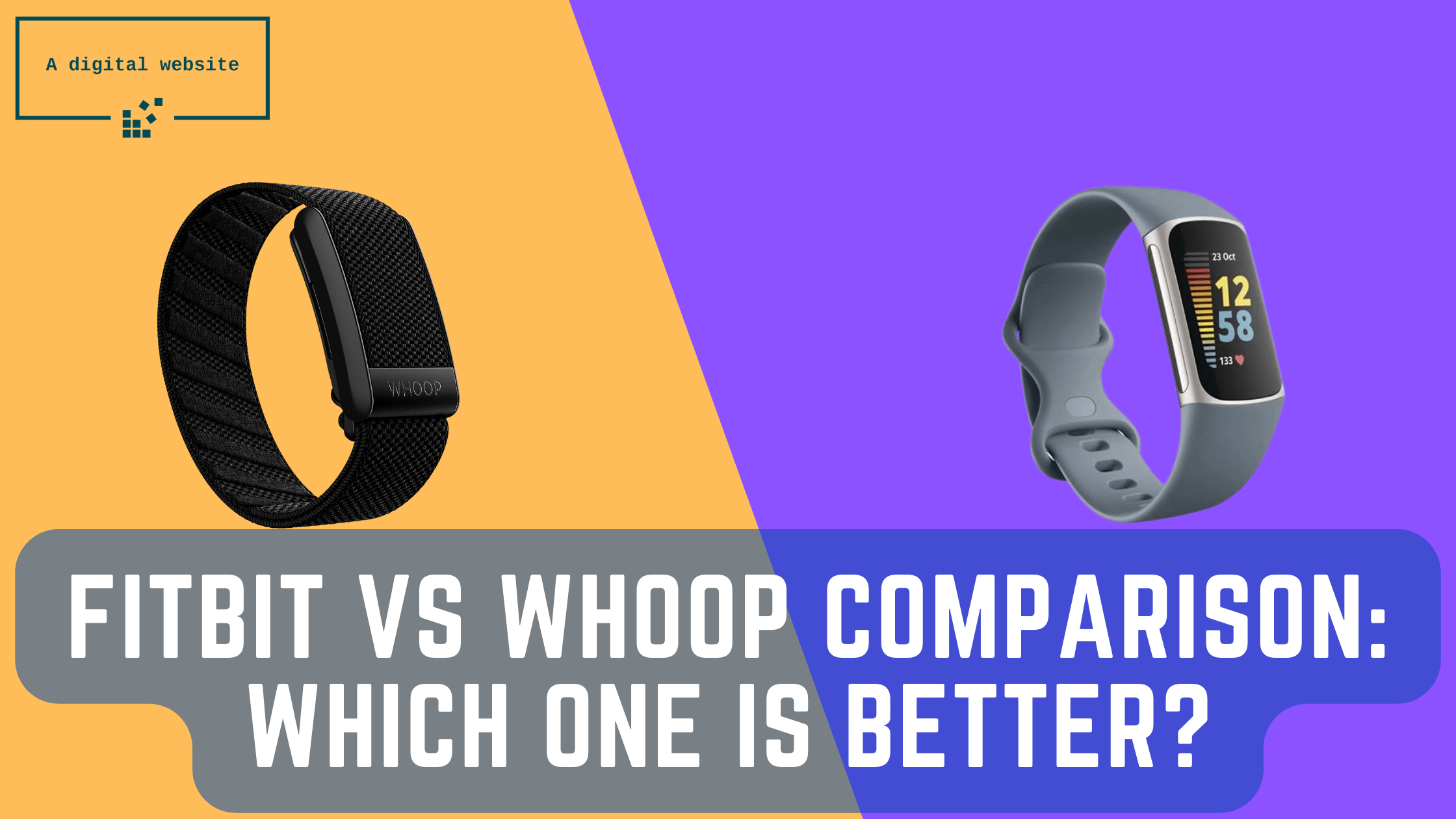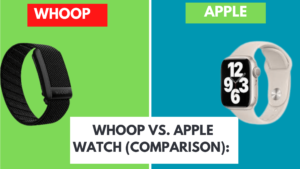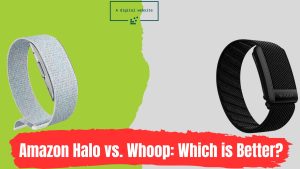Fitbit and Whoop are widely recognized names in the fitness wearable market. Both claim to be the ultimate health and fitness companion and possess similar capabilities for tracking workouts and monitoring well-being. Both devices can meticulously assess your activity and encourage you to lead a healthy lifestyle.
However, the minor and significant differences between them are worth noting, especially if you’re new to the wearable device sphere. Fitbit and Whoop have their strengths and weaknesses, some of which may influence your purchasing decision. For instance, Whoop lacks a screen, whereas most Fitbits have one.
In fact, the differences extend far beyond this, so you need to read this Fitbit vs Whoop comparison guide to the end. Of course, Fitbit sells a wide range of trackers and smartwatches, while Whoop can offer only one. To make it fairer, we decided to compare the Fitbit Charge 5 and the Whoop 4.0, as they have the same form factor for wearing. Here’s a comparison of their features and functionalities.
Fitbit vs Whoop: Design
We’ll start this comparison with design, where the two wearable devices differ the most. Fitbit Charge 5 and Whoop 4.0 look very premium and provide daily comfort. Neither of them resembles those bulky smartwatches that engulf the entire wrist.
Fitbit Charge 5
The Charge 5 boasts a slimmer profile than the latter and retains a vibrant 1.04-inch OLED touchscreen display. It displays key statistics and wrist notifications and provides access to various features. It also supports an “Always On Display” feature if you prefer constantly displaying the time or any metric on the screen.
The Charge 5 capsule is made of aluminum, which feels cool to the touch, and it utilizes a smart spring-loaded clasp mechanism, allowing users to interchange bands. Fitbit sells a wide range of bands for any occasion. The Charge 5 lacks a physical side button, unlike the Versa and Sense models. Using a touchscreen as the sole input sometimes creates navigation hurdles.
Like all current-generation Fitbit models, the Charge 5 is water-resistant up to 50 meters, which is ideal for swimming, showering, and water-related household chores.
Whoop 4.0
The Whoop band has a rather bold yet divisive design. It doesn’t resemble any other fitness tracker currently on the market. This screenless tracker snugly fits into a knitted textured strap held by a stylish metal buckle. It may take some effort initially to put it on the wrist, but once it’s in place, it resembles more of a fashion accessory than most fitness trackers.
Like Fitbit, you can swap the knitted band with other Whoop accessories to create a different look. You can also position the tracker on the wrist, and biceps, sleeves, and unique apparel are in the Whoop store. However, Whoop strongly recommends wearing the tracker on the wrist for the first 30 days to establish baseline metrics before wearing it in other locations.
The Whoop 4.0 itself looks exceptional. Many appreciate the option to wear it on a different body part besides the wrist. Of course, it lacks a screen, and users have to check the app for data, but some may find this beneficial as it avoids unnecessary distractions.
Lastly, the Whoop 4.0 is IP68 certified, meaning it’s dust and water-resistant. It can withstand immersion up to 10 meters for two hours. We can find our guide on cleaning the Whoop strap helpful.
Fitbit vs Whoop: Fitness and Health Tracking
Fitbit and Whoop confidently assert that their trackers are best-in-class for monitoring fitness and health status. While they differ in many aspects, both provide reliable wellness tools to inform users about their physical activity.
Fitbit Charge 5
The Charge 5 represents the pinnacle of fitness tracking technology, leveraging cutting-edge sensors from the Versa and Sense smartwatches. It can track heart rate 24/7 (even during workouts), step count, calories burned, and sleep duration. It features a built-in GPS, conveniently tracking your route during outdoor activities without needing a phone. Motion sensors (gyroscope and accelerometer) track your movements indoors.
Additionally, the Fitbit Charge 5 has an impressive array of health sensors. It includes an FDA-certified ECG sensor for in-depth heart rate measurements, an EDA sensor that detects electrodermal activity to assess stress levels, and a SpO2 sensor for measuring blood oxygen saturation.
The ECG sensor on Fitbit can detect early signs of heart conditions such as atrial fibrillation, which causes irregular heart rhythms and increases the risk of stroke and heart failure, among other cardiac complications.
The optical heart rate sensor, infrared SpO2 monitor, and temperature sensor track blood oxygen levels and skin temperature during nightly activities. These data can be valuable for predicting signs of common illnesses and sleep disturbances such as sleep apnea.
The EDA (electrodermal activity) sensor on the Charge 5 can identify tiny changes in sweat levels on your skin to measure your body’s stress response. The Fitbit app then combines these metrics with sleep and heart rate variability data to assess your daily stress management score.
Fitbit provides over 20 workout modes built into the Charge 5 and supports automatic exercise recognition for various indoor and outdoor activities. This is comparable to specialized sports watches, providing high accuracy and a comprehensive dataset. However, they could be better and may sometimes be inaccurate.
We cannot say anything new about the Fitbit app except that it offers a comprehensive user experience and is easy to use. However, users require a Fitbit Premium subscription to access additional metrics, scores, workout modes, audiovisual guides, personalized coaching advice, and more.
Whoop 4.0
The Whoop 4.0 band is also indispensable when it comes to health tracking. It can monitor resting heart rate, heart rate variability, respiratory rate, SpO2 level, and skin temperature and track your sleep.
However, it does not count steps and instead focuses on cardiovascular strain. Additionally, it lacks GPS and relies on your phone’s GPS for outdoor activity tracking. The Whoop band also automatically recognizes various exercises and activities, similar to Fitbit.
Unlike Fitbit, it does not provide detailed assessments of your actual workouts. Instead, it shows the impact on your body post-exercise to inform you how much rest you need before your next workout. Whoop is entirely focused on providing these data, which are crucial for professional athletes.
The tracker’s advanced heart rate sensor and continually evolving algorithm sets quantify your daily cardiovascular strain and heart rate data to assess your strain and how it affects your body’s recovery the following day.
One key aspect where Whoop triumphs over competitors is sleep tracking. The tracker can determine your sleep stages and correlate collected data with other health metrics to provide a sleep score from 0 to 100 the next day, along with detailed mindfulness insights. When the device believes you’ve fully recovered or achieved your sleep goal, it also wakes you with a gentle tactile alarm.
It’s important to note that none of the sensors are FDA-approved, so users cannot trust Whoop’s internal research. However, the health monitoring feature provides fairly accurate metrics and alerts when users exhibit early symptoms of common illnesses. The Whoop app also allows users to print data for sharing with healthcare professionals.
Fitbit vs Whoop: Battery Performance
While both fitness trackers offer comparable battery life, the Fitbit Charge 5 outperforms the Whoop 4.0 tracker, lasting a day or two longer despite featuring a screen and built-in interface. Of course, this assumes you’re not using built-in GPS or the “Always On Display” feature, which can halve or even lessen standby time. It typically takes around two hours to charge the Charge 5.
Whoop 4.0 promises a 5-day battery life, which is also quite respectable. While it doesn’t support fast charging, the unique battery pack allows users to charge their Whoop without even taking it off. It attaches directly on top of the tracker without appearing cumbersome. You can charge the battery using a USB-C charging device.
Fitbit vs Whoop: Smart Features
In this aspect, Fitbit undoubtedly takes the lead. The Charge 5 has a color screen that allows you to view your daily stats, select workouts and exercise modes, and even display the time like traditional wristwatches.
Additionally, you can view incoming phone notifications on the screen and respond to them with predefined replies. The tracker also supports NFC contactless payments. And in the latest Fitbit firmware update, they’ve also added a “Find Phone” feature, allowing users to ping and locate their phones.
None of these features are available in the Whoop 4.0. Users must check their fitness and health data using the Android/iOS app. The device focuses on gathering your biometric data, which it does exceptionally well.
Fitbit vs Whoop: Pricing and Verdict
We conclude this Fitbit vs Whoop comparison with a brief discussion on pricing. If you already know how much these two wearables cost, you’ve already made a purchasing decision. Assuming you still need to do so, here’s what you need to know about the Fitbit Charge 5 and Whoop 4.0 prices.
The Whoop 4.0 is exclusively available through a subscription, starting at $30 per month with a minimum commitment of 12 months. You can save $60 by opting for an annual membership and paying $300 upfront.
In comparison, the Fitbit Charge 5 is a one-time purchase costing $150, at least at the time of writing. This is half of what you would pay for a yearly membership to Whoop, and the Fitbit Premium subscription is optional. With the annual fee of Whoop 4.0, you could purchase the flagship Fitbit Sense smartwatch!
Therefore, for the average consumer, the Fitbit Charge 5 is the better fitness tracker of the two. They are cost-effective in the long run, provide a balanced combination of fitness tracking and health monitoring, and function as everyday wristwatches.
But if you already own smartwatches and are looking for a discreet fitness tracker better to understand your sleep, strain, and recovery metrics, then the Whoop 4.0 is what you need. You’ll appreciate the in-depth health analysis offered by the Health Monitor feature. And if you have an iPhone, you’ll be pleased to know that Whoop integrates excellently with Apple Health and Strava.




